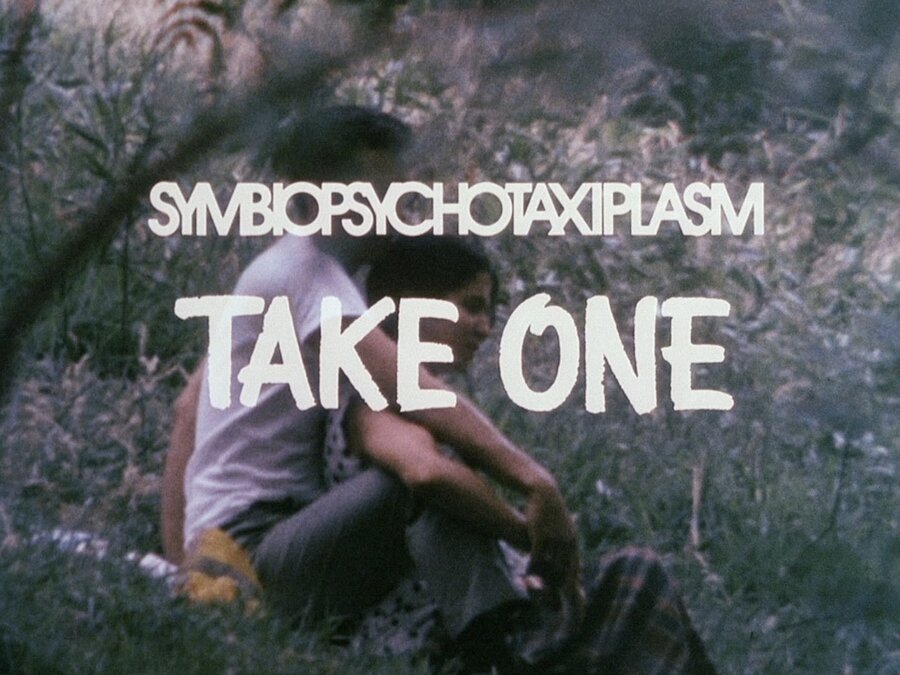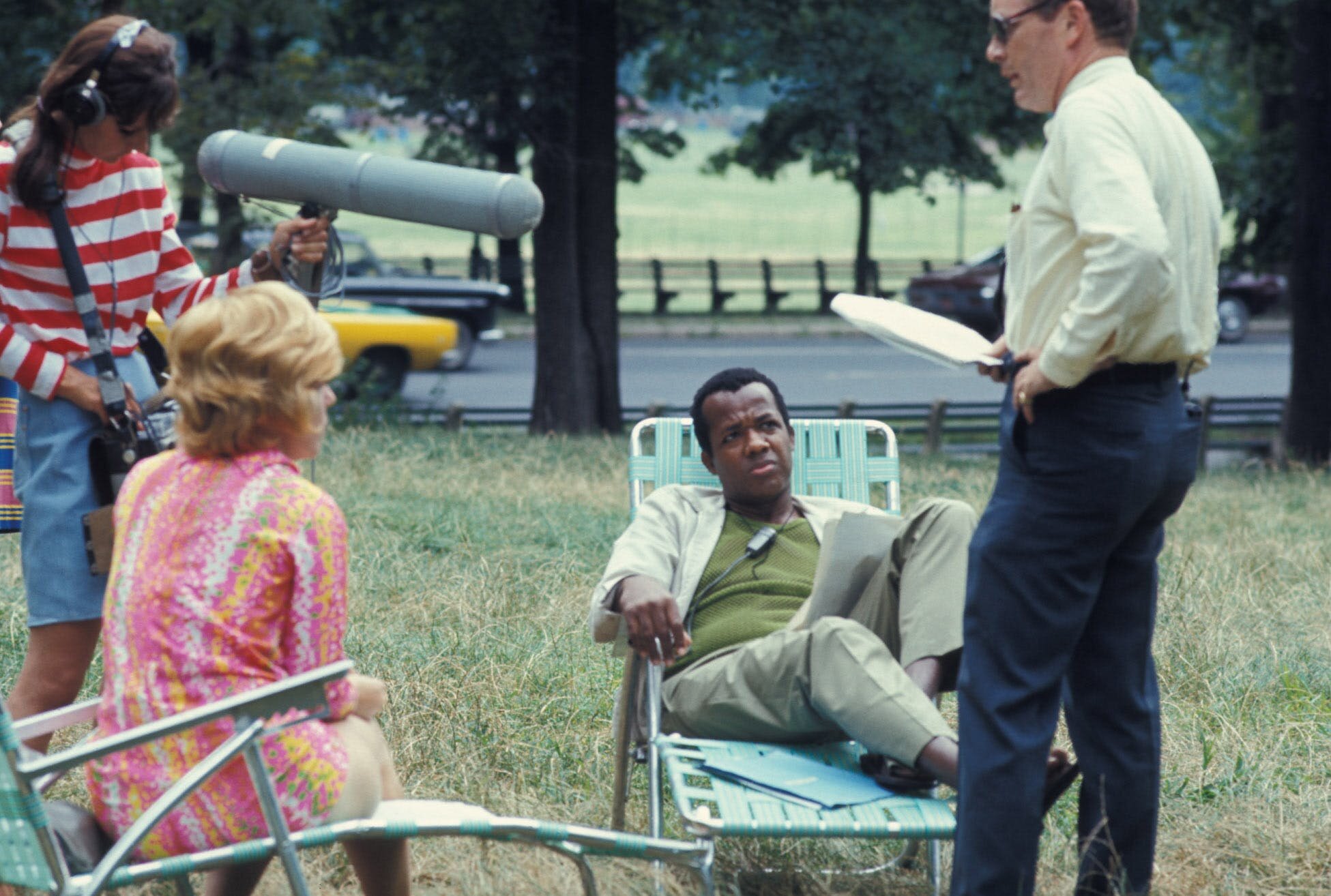Art vs. Artifice
In the Spring of 1968, William Greaves set out to make a film about filmmaking. He called it “a fragment of the Godhead which is made up of other Godhead fragments.” This movie became Symbiopsychotaxiplasm: Take One (1968).
Symbiopsychotaxiplasm is a deconstruction of the filmic form. The basic elements of the cinema are based around the non-existence of apparent camera and sound equipment. Based on the Hollywood-Mosfilm model by which most films are created, filmmaking techniques are supposed to be invisible.
Greaves created a screen test for his actors and assigned three cameras to film the event. The first camera focuses on the actors and the scene. The second camera focuses on the first camera crew filming the actors. The third camera focuses on the first camera, second camera, and the actors –basically everything encompassed in the filmmaking process.

The point of view that Greaves holds on filmmaking is the film will tell itself. A director is “a person who gets his ego out of his own way, he is at best a collaborator and servant of nature… but who, paradoxically, firmly controls the conditions of spontaneity, theatricality, and drama on the set.” His attempts at creating a short narrative-transitive based scene in a largely narrative-intransitive film are his means of exposing the constructs of the scene and film as a storytelling medium. A documentary is based on the assumption that the events, people, and places exist and are presented by a reliable source. Here, Greaves exploration of the documentary is comparable to jazz. The assumption is that it is based on improvisation and spontaneity in filmmaking and that it does not come out of rehearsal and interference. At any point, the film could have been based in the created reality of fiction or the experienced reality of documentary.
The Symbiopsychotaxiplasm moment explores the idea of one of these two realities on film. Our perception of a film is the impression of a reality we have upon viewing, whether fiction against documentary or narrative against avant-garde. It is similar to the Basic Cinematographic Apparatus (the impression of reality based on the recording of images and their reproduction to be projected) that Jean-Louis Baudry presented. Greaves attempts to present in Symbiopsychotaxiplasm the Basic Cinematographic Apparatus that “offers the subject perception ‘of a reality’ whose status seems similar to that of representations experienced as perception.”
Throughout the film, there are several moments at which the crew discusses the evolution of the filmmaking process. They film themselves without the director present, only to help document the process for the director later since he is also his own editor. These moments of reflection by the crew are all under the assumption that the director did not instigate their discussions or influence their moments of self-expression about the film.
When the film crew later confronts the director about the project and their own conflict and confusion, Greaves tells them, “It’s a circus with a better script.” He wants to improvise something that is better than the written screen test as a reflection of the ‘establishment’ and a representation of the counter-cultural sentiments in the US at the time. It is a “creative piece of cinematic experience” as Greaves divulges his own expectations to the crew following eight days of filming the same screen test repeatedly with occasionally different actors.

This experiment in filmmaking took nearly 130,000 feet of 16mm film (or roughly 55 hours). A producer -impressed with Greave’s previous documentary work- funded the Symbiopsychotaxiplasm Operation. The producer told him to make whatever he wanted. With complete control over his project, Greaves could create a film without the limitations of having overbearing control of producers and investors. The film’s photography was finished in 1968, though it took three years to finish the editing before a print was struck in 1971. At that time, Greaves took it to the Cannes Film Festival where it was screened. The projectionist confused the reels of the film and the screened film was nearly indecipherable for the audience, losing most of any chance for it finding an audience.
The confusion of reels on an experimental film such as Symbiopsychotaxiplasm would ruin the point of a documentary exploring the concept of filmmaking. After editing 55 hours of footage down to 75 minutes, the apparent narrative structure of the film would be loss as it is an experiment in storytelling. The intended presentation was made in editing. As in the film itself, Greaves explores the film developing as it is shot based on idea and not story. The structure of the filmic narrative came from the filming and editing of an idea, not from the story, script, and overall pre-production process.

Symbiopsychotaxiplasm is a learning experience. It is not only an attempt to capture a moment, whether reality or simulacrum of reality, that is essential in understanding film as a form. A film does not have to be entertaining by conventional means if it is interesting. A film can be intellectually stimulating as it attacks the viewer’s perception of film and still be a worthy experience for the film viewer.
Symbiopsychotaxiplasm can also be used to examine a breakdown of storytelling. The crew in one scene examines the possibility that at any point the director might be hiding on the other side of a wall directing them and their discussion of the process of making a film. They are discussing whether or not Greaves is controlling the theatricality of capturing reality and what is presented, as reality could very well be fiction.
A story is presented based on the assumption that it is either a documentary or fiction. The film is the reflection of the intended vision by the filmmaker. It could be the focus of the camera or the order in which it is edited that determines a vision if it is not already present in the screenplay or design. By blurring the line between reality and fiction, Greaves expressed an element of himself and the experimentation that he sought in creating this film. It is a reflection of an author with the contribution of the cast and crew. The director becomes the so-called ‘Godhead’ that Greaves believed his film represented as the crew became the ‘fragments of the Godhead.’
In the same year that William Greaves was making Symbiopsychotaxiplasm, Jean-Luc Godard was working on his film One AM (1968) which pursued similar themes. Though Godard abandoned the film in postproduction, it paralleled Symbiopsychotaxiplasm as an approach to the filmic experience that Godard shot in Chicago. Both films were attempts at counter-cinema and Symbiopsychotaxiplasm can be compared to Peter Wollen’s breakdown of the revolutionary countering elements that Godard used in his cinema of the late 1960s. They are:
-
Narrative Transitivity / Narrative Intransitivity: The narrative is not transitive as it is built upon episodes of a screen test filmed repeatedly, sometimes with different actors and intermittent moments of digression as Greaves plays the role of director and stops them in the acting exercise.
-
Identification / Estrangement: The characters are estranged from the audience, as they are breakdowns of characters themselves. The crewmembers are the only people to which identification can be found as they struggle to understand what is actually going on in the film alongside the audience.
-
Transparency / Foregrounding: The mechanics of filmmaking are visible throughout the film, foregrounding the fact that this is a movie and a not a suspension of disbelief.
-
Single Diegesis / Multiple Diegesis: The film presents multiple diegesis, as there are separate worlds for the film within the film and an overarching documentation of the separate worlds presented.
-
Closure / Aperture: The film is based on the idea that the audience understands the role of film and the crew apparent in the filmmaking process. This creates a world based on the intertextuality of not only referencing the filmmaking world, but also the process of interaction in presenting a reality of any sort.
-
Pleasure / Unpleasure: The experience of the viewer in watching this film is not to be entertained, but to challenge the viewer in his/her perception of film and what is the actual reality presented.
-
Fiction / Reality: The film is itself a questioning of fiction pitted against reality. At which point does the capturing of a reality become a representation of that reality or does it always become a representation of the filmmaker.
Symbiopsychotaxiplasm created its own counter-cinema model parallel to Godard. Godard would be the more cited individual in film history as he was already famous by the time he decided to pursue counter-cinema, breaking with the traditional filmmaking model of logical narrative progression. It was Greaves’ struggle and passion for filmmaking that led him to create a film such as Symbiopsychotaxiplasm: Take One.
Links
Films
-
*Symbiopsychotaxiplasm: Take One (1968) [IMDb // Letterboxd]
-
Discovering William Greaves (2006) [IMDb // Letterboxd]
People
Reference
Articles
-
Baudry, Jean-Louis. “The Apparatus: Metapsychological Approaches To The Impression Of Reality In Cinema.” Film Theory And Criticism. Ed. Leo Braudy and Marshall Cohen. 7th ed. New York: Oxford UP, 2009. 171-88. Print.
-
Wollen, Peter. “Godard And Counter Cinema: Vent D’Est.” Film Theory And Criticism. Ed. Leo Braudy and Marshall Cohen. 7th ed. New York: Oxford UP, 2009. 418-26. Print.
